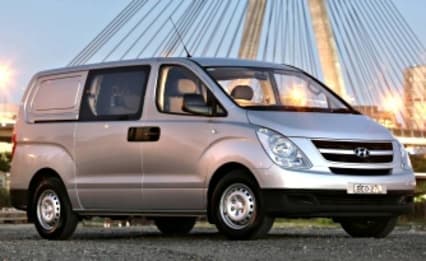
Hyundai iLoad 2009 Review
- Hyundai iLoad
- Hyundai ILOAD 2009
- Hyundai iLoad Reviews
- Hyundai Reviews
- Hyundai Commercial Range
- Commercial
- Hyundai
That's because vans are the lowest form of vehicle life and can be far, far less appealing than a gym treadmill.
Vans are the automotive equivalent of the primates and, likewise, have only one way to evolve — upwards.
Tragically — and I mean that literally given the appalling lack of safety equipment in these vehicles that cover great distances in appalling global traffic and weather conditions — life for a van has barely evolved.
That impacts directly on the van occupants. On a safety scale, as measured by safety group ANCAPS, vans barely rate above two out of a possible five stars.
And that hasn't changed for decades.
At least vans are getting more interesting to drive.
The Hyundai iLoad comes with a turbo-diesel engine that pulls so hard you'll be reluctant to leave the driver's seat. Driving this may make you smile and that's something a treadmill never does for me.
It gets two airbags for its potential of three occupants, together with ABS working on four-wheel ventilated discs and electronic brakeforce distribution to allocate maximum brake pressure to the right wheels.
Drivetrain and chassis
Vans are inherently awkward and unstable. They need things like electronic stability control to minimise the possibility of collisions or uncontrollably leaving the road.
Not one van manufacturer offers ESC as standard though, to be fair, it's on the option lists.
Hyundai offers ESC and traction control as a $700 option on the diesel version of the iLoad.
Do not even consider leaving the dealership without this option. The iLoad's combination of an empty rear cargo area, live rear axle with leaf springs and commercial tyres is the ideal recipe for sliding out on wet roads.
That takes the price of the iLoad turbo-diesel manual to $35,190 and directly comparable with some fine European vans.
That's dangerous territory for this South Korean.
The 2.5-litre turbo-diesel is one of the latest from Hyundai and has all the right acronyms attached to its designation.
Power is 125kW at 3800rpm and simply trounces its rivals. Torque is also well above par at 392Nm that sits on a plateau at 2000-2500rpm.
The slick five-speed manual makes the most of the torque with eager acceleration.
Though it's a commercial machine and has less sound deadening than a passenger car, the diesel was quiet enough inside the cabin to be passed off as a petrol.
Exterior and interior
The iLoad scores well in all the important areas. It looks decent — and as a guide, the Kia Pregio did not — and is certainly accommodating.
There are two side sliding doors for excellent access and a big lift-up hatch at the back. Barn doors which accept pallet widths are also available.
It sits high — but in this market, what doesn't? — for excellent visibility forward and to the side.
The test van was blind — no side windows — and that's pretty much how you feel when changing lanes or looking up a side street while reversing. If possible, consider adding a left-side window.
There are six tie-down loops in the floor with space for more and some half-height wall panelling to help dull road boom and minimise sheet metal damage.
Hyundai claim 1132kg payload for this van and that is generally higher than its rivals.
Cabin treatment is very good with care taken to look after the needs of the worker.
There's plenty of storage space including four cupholders — two within the fold-down centre seat back that also incorporates recesses for paperwork and personal items — plus double-storey door inserts and glovebox.
Big, simple instruments and switchgear is welcome. Unwelcome is the audio's volume knob placed on the left of the radio which is a bit far for the driver to lean over.
The gearlever protrudes from a dash extension leaving a bit of room for the driver to slide through to the passenger side. This small space is also where the third occupant must locate their legs.
Cabin materials are neat, functional and attractive in a King Gee sort of way. Clearly, car design has made its presence in the interior of this van.
ON THE ROAD:
I went from road testing a Porsche Carrera to the iLoad and I don't have to tell you that there were some differences. The iLoad was white; the Porsche brown.
Like all van makers, Hyundai tries to stem any occupant damage caused by a frontal prang by employing a bulbous nose.
Bit like sparring with Gerard Depardieu in that what could be major damage is really only superficial.
That adds some comfort to the occupants.
It sits solid on the road thanks to its wide track and the surprisingly high weight of almost 2.1 tonnes dry.
The steering suits the van's purpose, as does the ease of the mechanical motions such as the clutch and gear lever.
Not predicted was the spirit of the engine. This things dazzles and may shock other road users with its briskness away from the traffic lights.
It sits comfortably at 100km/h with a very subdued engine noise. The main noise is the boom of the empty van and the roar of the commercial-grade tyres on coarse-chip bitumen.
It's not a machine to rush into a corner — reasons start with its high centre of gravity and end with the lack of ESC — though will tolerate winding country roads when the speed is sensible.
From predominantly city driving through to a squirt in the country, the iLoad diesel manual averaged 9.6 litres/100km. That equates to a 780km range.
Hyundai claims 8.5 l/100km and that's attainable with greater country or freeway road use.
The purchase price is close enough for buyers to look at Toyota and the European competitors, as is the fuel economy.
But no-one matches the iLoad's five-year or 160,000km warranty that includes 12 months of roadside assistance.
Models and pricing:
The turbo-diesel van costs $34,490 plus on-road costs and another $700 for the ESC/traction control package.
But iLoad prices start at $29,990 for the 2.4-litre petrol van with five-speed manual.
There is also:
iLoad turbo-diesel auto ($36,990); iLoad crew van petrol ($31,990); crew van diesel ($36,490); and crew van diesel auto ($38,990).
Options include metallic paint ($350); ESP and traction control for the diesels ($700); and locking rear diff ($700).
Snapshot
Price: $34,490
Engine: 2.5-litre, 4-cyl turbo-diesel
Power: 125kW @ 3800rpm
Torque: 392Nm @ 2000-2500rpm
Fuel economy (official): 8.5 litres/100km, (tested): 9.6 litres/100km
Transmission: five-speed manual; rear drive
Pricing guides
Range and Specs
| Vehicle | Specs | Price* | |
|---|---|---|---|
| Crew | 2.4L, PULP, 5 SP MAN | $10,010 – 13,640 | 2009 Hyundai ILOAD 2009 Crew Pricing and Specs |
| (base) | 2.4L, PULP, 5 SP MAN | $9,020 – 12,760 | 2009 Hyundai ILOAD 2009 (base) Pricing and Specs |
$9,990
Lowest price, based on 13 car listings in the last 6 months


















